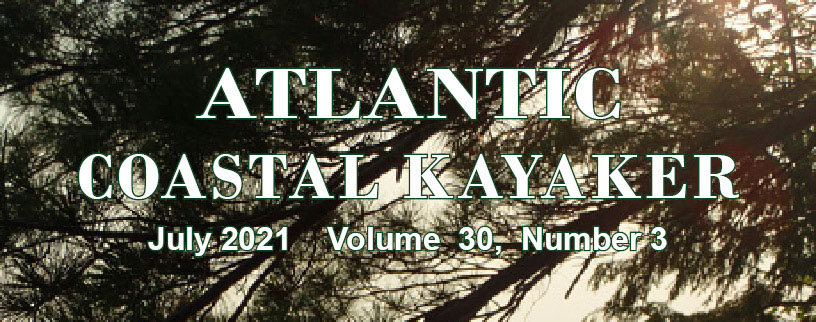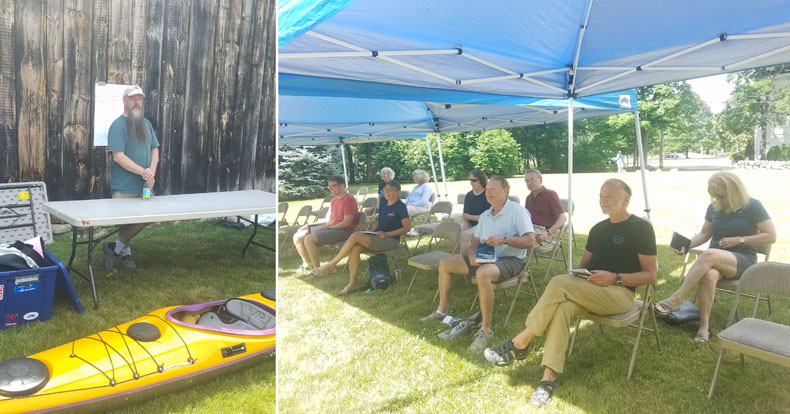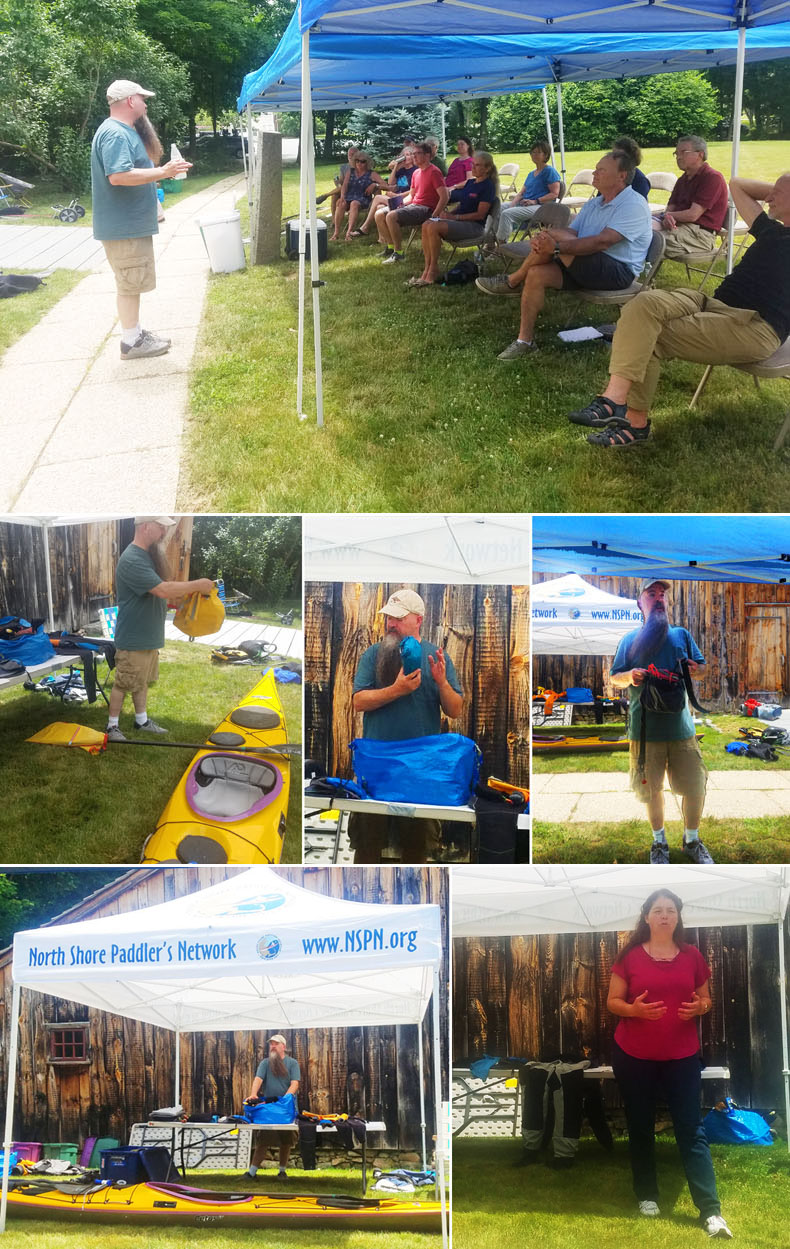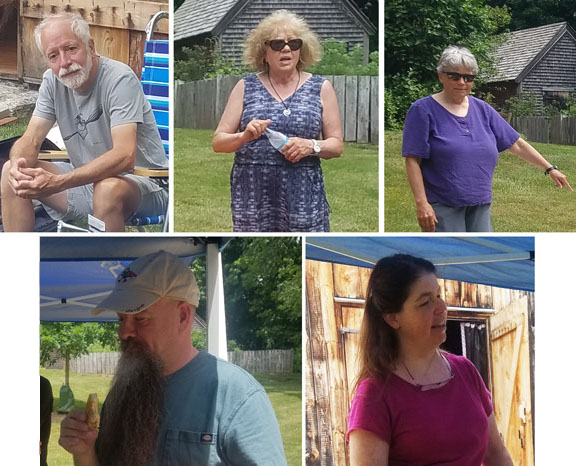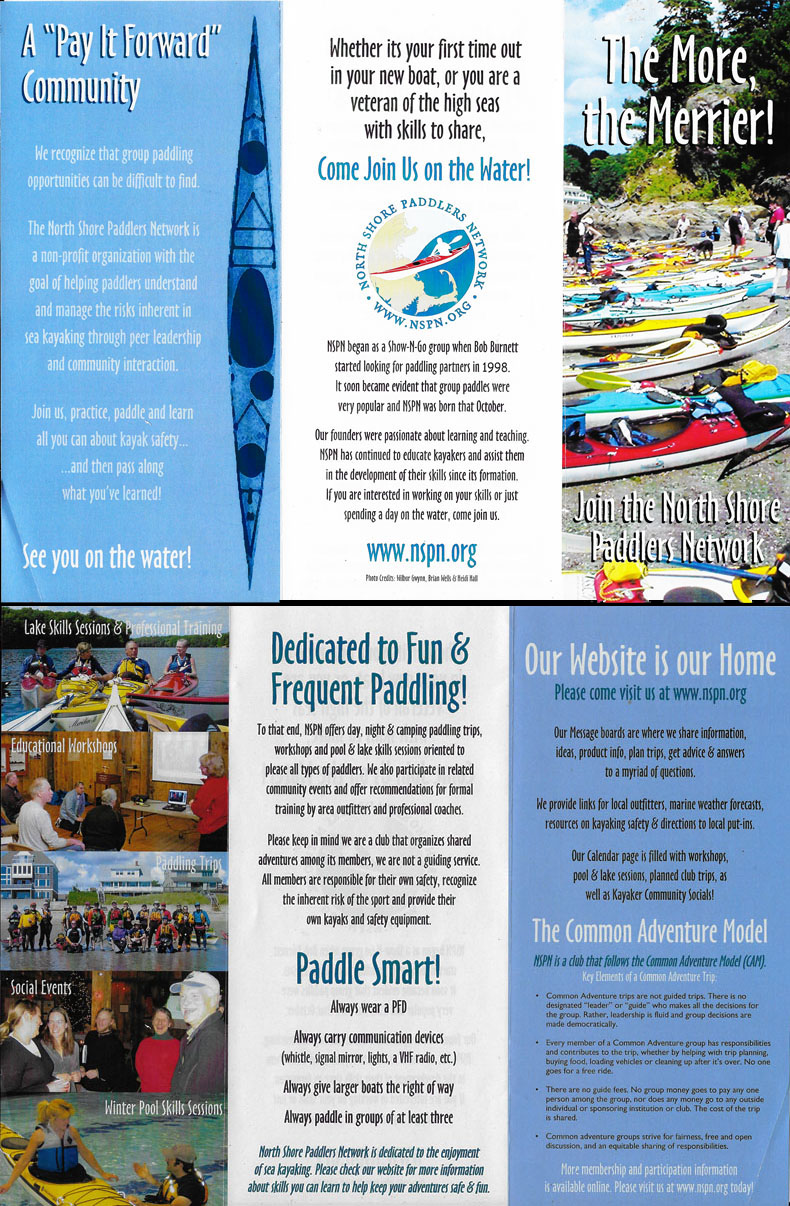|
|
|
Cathy Folster oversees the sign-in.
NEW TO SEA KAYAKING WORKSHOP
It was 10:00 A.M., Saturday, June 26, one of those screechingly hot and humid days I usually associate with deep summer, and that invariably starts the 60s hit "Ode to Billy Joe" mindworming in my skull. I had traveled to the picturebook town of Topsfield, Mass., and located the historic Gould Barn, just off the town square. Today I would be off the water, but would spend the next several hours at the New to Sea Kayaking Workshop, presented by the North Shore Paddlers Network (NSPN).
Rob welcomes the participants, who gratefully listen in the shade. So heading up the path from the parking lot kiosk, I approached the barn and signed in. There were a couple of tents with chairs for the participants, a line of brightly colored kayaks of various designs spread out on the adjacent lawn, tables with several bins of gear, and a number of paddles of various designs. It was clear this was a very well-organized proceeding, showing long experience and dedication.
NSPN had a variety of kayak types available to examine, and Rob, Mike, Sue, and Beth talk about the differences. After some introductory remarks, we soon gathered on the sloping lawn to hear various speakers describing the line of boats on display, ranging from broad. flat-bottomed "lifestyle" boats suitable for sheltered waters to lean, mean paddling machines meant for use on the open ocean. Aspects of design, hull shape, size, and such questions as skeg vs. rudder vs. nothing on the stern were covered. There was also some explanation of differing construction methods, including polyethylene roto-molding, composite fiberglass and Kevlar layups, and thermoforming. There was one home-made fuselage frame kayak there (skin-on-frame construction, like an old biplane body), but no folding or inflatable boats, and I got the distinct impression that NSPN members prefer hard shell kayaks with waterproof bulkheads, despite the fact that skin-covered, folding and inflatable craft have been used on many expeditions in some of the most extreme paddling conditions. (Paddling.com has a good article on the various materials in kayak construction.) Two other requirements for kayaks are a relatively clear deck for helping with rescues and grablines ("NOT BUNGIES!") all around the boat.
Beth, Mike, and Rob discussing paddles and spray skirts, two of the four essential gear types for sea kayaking. Finishing with the boats, we repaired to the shade of the tents for a discussion of paddles and spray skirts. (Paddling Magazine has a good discussion on paddle types.) Wood, carbon fiber, fiberglass, plastic, straight or bent shaft, feathered blades or not, Greenland, Euro, or wing blades, the combinations seem endless. NSPN presenters passed around a few examples and discussed sizing. (Paddling Magazine has a good discussion on paddle types.) Then we got into choosing a spray skirt and looked at a few PFDs as well. (As Rob explained, the old name of "life jacket" is apparently coming into vogue again, although very few PFDs designed for sea kayaking will actually preserve life by holding the face out of the water if the boater is unconscious.) This finished the morning and the discussion of NSPN's four essentials of sea kayaking gear: boat, paddle, spray skirt, and life jacket.
Lunch was a time for more questions and explanations, as well as some really excellent pizza.
After a provided lunch of pizza and bottled water, the discussion turned to other, less basic types of gear such as marine radios and compasses. Rob held up a radio and asked, "How many people own one of these?" and a few hands went up, including mine. "And how many actually know how to use one?" and the hands went down, including mine. We-e-ell, I just need to review the manual.
Rob talks about non-essential but useful gear, while Cathy goes into clothing choices. The final activity of the day had to do with proper dress when out on the ocean. We were divided into groups of two or three. Each group was given a large sheet of paper with a stick figure, and air and water temperatures on it, The task was to dress the figure properly based on the conditions. Our sheet said 90 degrees air and 40 degrees water, a dismal combination! But we went with the recommendations, and had the poor sap in light or medium weight longjohns and a dry suit. I have been there, and it is a great way to lose water weight (sweat) in your own private steambath. But no cold water shock if you flip. And so the meeting wrapped up. A lot of questions had been asked and more answers had been given, and everyone seemed to have learned something new about this simple but surprisingly complex sport call sea kayaking. And what was my revelation after 45 years of paddling? That working with a group of dedicated, knowledgeable, and skilled paddlers like the members of NSPN keeps the ideas coming, the sport fresh, and the skills up-to-date, even after so long a time. North Shore Paddlers Network
According to the blurb in the invite, NSPN, founded in 1998, "is a non-profit organization devoted to helping sea kayakers at all levels enjoy the ocean and improve their skills. Our home base is the North Shore of Massachusetts, but we range up and down the beautiful New England coastline.
NSPN's volunteer presenters, from top left to bottom right: Mike Habich, Sue Hriciga, Beth Sangree, Robert Folster, Cathy Folster.
|
|
|
